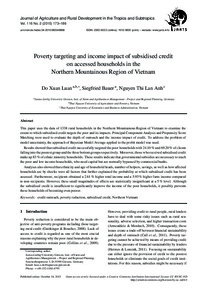Aufsatz

Poverty targeting and income impact of subsidised credit on accessed households in the Northern Mountainous Region of Vietnam
Zusammenfassung
This paper uses the data of 1338 rural households in the Northern Mountainous Region of Vietnam to examine the extent to which subsidised credit targets the poor and its impacts. Principal Component Analysis and Propensity Score Matching were used to evaluate the depth of outreach and the income impact of credit. To address the problem of model uncertainty, the approach of Bayesian Model Average applied to the probit model was used.
Results showed that subsidised credit successfully targeted the poor households with 24.10% and 69.20% of clients falling into the poorest group and the three bottom groups respectively. Moreover, those who received subsidised credit make up 83% of ethnic minority households. These results indicate that governmental subsidies are necessary to reach the poor and low income households, who need capital but are normally bypassed by commercial banks.
Analyses also showed that ethnicity and age of household heads, number of helpers, savings, as well as how affected households are by shocks were all factors that further explained the probability at which subsidised credit has been assessed. Furthermore, recipients obtained a 2.61% higher total income and a 5.93% higher farm income compared to non-recipients. However, these small magnitudes of effects are statistically insignificant at a 5% level. Although the subsidised credit is insufficient to significantly improve the income of the poor households, it possibly prevents these households of becoming even poorer.
Results showed that subsidised credit successfully targeted the poor households with 24.10% and 69.20% of clients falling into the poorest group and the three bottom groups respectively. Moreover, those who received subsidised credit make up 83% of ethnic minority households. These results indicate that governmental subsidies are necessary to reach the poor and low income households, who need capital but are normally bypassed by commercial banks.
Analyses also showed that ethnicity and age of household heads, number of helpers, savings, as well as how affected households are by shocks were all factors that further explained the probability at which subsidised credit has been assessed. Furthermore, recipients obtained a 2.61% higher total income and a 5.93% higher farm income compared to non-recipients. However, these small magnitudes of effects are statistically insignificant at a 5% level. Although the subsidised credit is insufficient to significantly improve the income of the poor households, it possibly prevents these households of becoming even poorer.
Zitierform
In: Journal of Agriculture and Rural Development in the Tropics and Subtropics. Kassel : Kassel University Press. - Vol. 116, No. 2 (2015), S. 173-186Sammlung(en)
Vol 116, No 2 (2015) (Journal of Agriculture and Rural Development in the Tropics and Subtropics (JARTS))Zitieren
@article{urn:nbn:de:hebis:34-2015080548898,
author={Luan, Do Xuan and Bauer, Siegfried and Thi Lan Anh, Nguyen},
title={Poverty targeting and income impact of subsidised credit on accessed households in the Northern Mountainous Region of Vietnam},
year={2015}
}
0500 Oax 0501 Text $btxt$2rdacontent 0502 Computermedien $bc$2rdacarrier 1100 2015$n2015 1500 1/eng 2050 ##0##urn:nbn:de:hebis:34-2015080548898 3000 Luan, Do Xuan 3010 Bauer, Siegfried 3010 Thi Lan Anh, Nguyen 4000 Poverty targeting and income impact of subsidised credit on accessed households in the Northern Mountainous Region of Vietnam / Luan, Do Xuan 4030 4060 Online-Ressource 4085 ##0##=u http://nbn-resolving.de/urn:nbn:de:hebis:34-2015080548898=x R 4204 \$dAufsatz 4170 7136 ##0##urn:nbn:de:hebis:34-2015080548898
<resource xsi:schemaLocation="http://datacite.org/schema/kernel-2.2 http://schema.datacite.org/meta/kernel-2.2/metadata.xsd"> 2015-10-26T13:51:46Z 2015-10-26T13:51:46Z 2015-10-14 1612-9830 2363-6033 urn:nbn:de:hebis:34-2015080548898 http://hdl.handle.net/123456789/2015080548898 eng Kassel University Press Urheberrechtlich geschützt https://rightsstatements.org/page/InC/1.0/ credit outreach poverty reduction subsidised credit Northern Vietnam 630 Poverty targeting and income impact of subsidised credit on accessed households in the Northern Mountainous Region of Vietnam Aufsatz This paper uses the data of 1338 rural households in the Northern Mountainous Region of Vietnam to examine the extent to which subsidised credit targets the poor and its impacts. Principal Component Analysis and Propensity Score Matching were used to evaluate the depth of outreach and the income impact of credit. To address the problem of model uncertainty, the approach of Bayesian Model Average applied to the probit model was used. Results showed that subsidised credit successfully targeted the poor households with 24.10% and 69.20% of clients falling into the poorest group and the three bottom groups respectively. Moreover, those who received subsidised credit make up 83% of ethnic minority households. These results indicate that governmental subsidies are necessary to reach the poor and low income households, who need capital but are normally bypassed by commercial banks. Analyses also showed that ethnicity and age of household heads, number of helpers, savings, as well as how affected households are by shocks were all factors that further explained the probability at which subsidised credit has been assessed. Furthermore, recipients obtained a 2.61% higher total income and a 5.93% higher farm income compared to non-recipients. However, these small magnitudes of effects are statistically insignificant at a 5% level. Although the subsidised credit is insufficient to significantly improve the income of the poor households, it possibly prevents these households of becoming even poorer. open access In: Journal of Agriculture and Rural Development in the Tropics and Subtropics. Kassel : Kassel University Press. - Vol. 116, No. 2 (2015), S. 173-186 Luan, Do Xuan Bauer, Siegfried Thi Lan Anh, Nguyen Gedruckte Ausg. im Verlag Kassel Univ. Press (www.upress.uni-kassel.de) erschienen. </resource>
Die folgenden Lizenzbestimmungen sind mit dieser Ressource verbunden:
Urheberrechtlich geschützt

